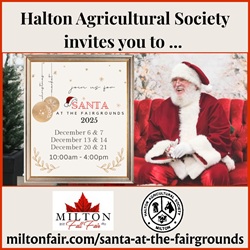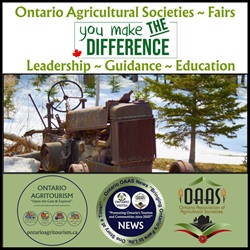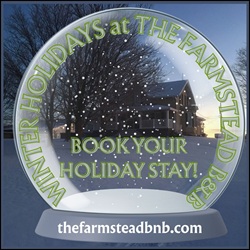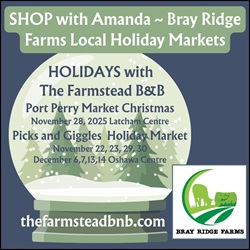Canada Agriculture and Food Museum
Judi “Scoop” McWilliams
“A Moment in Time!”
Ottawa is the home of the Canada Agriculture and Food Museum
We welcome you to come along as we Tour the Canada Agriculture and Food Museum …

The sun shone as we circled the final round-about toward the entrance of the Canada Agriculture and Food Museum.

We had driven many times through the massive fields around the Canada Agriculture and Food Museum complex, but for some reason never took the time to stop in. Today we were meeting with Kelly Ray, Marketing & Communications Officer who had graciously welcomed us for a personal guided tour. It seemed a little “surreal” as we neared the facility as many large barns and buildings glistened in the sun. We drove by several hay fields before we parked and walked up to the entrance.

The Canada Agriculture and Food Museum is located on a beautiful picturesque heritage site of the Central Experimental Farm, near the National Capital’s downtown core. It offers its visitors the unique experience of a fully functioning farm in an urban setting. As part of the Canada Science and Technology Museums Corporation, the CAFM is mandated to preserve Canada’s agriculture and food heritage, and to share and promote scientifically accurate knowledge about the way agriculture is best practiced and food produced and consumed in Canada.

Kelly met us with enthusiasm and our tour was about to begin. Kelly tells us the Canada Agriculture and Food Museum, in part, welcomes new comers to Canada and provides tours for children. Their greatest audience is young children and families. With that in mind, you can imagine how youth and family “visitor friendly” this facility is. This was apparent by the “stroller parking areas” set up outside many of the buildings. There is even a “quiet station” where mothers can take a time out to breast feed if they want with some privacy and quiet. They welcome over 160,000 visitors a year.

Research is a large component of the Canada Agriculture and Food Museum. For example, Kelly tells us the facility has been researching “winter proofing” wheat and crops where new techniques have been developed. Some examples include; soils and Canadian land inventory; food and dairy products processing technology; horticulture and ornamental plant breeding; agriculture engineering and farm mechanical systems; animal and poultry breeding and production; agricultural and forest insect identification and control methods; agricultural chemistry analysis methodology; plant and animal pathology, bacteriology and plant health; cereal and forage crop production utilization; tobacco; bee research.

This Canada Agriculture and Food Museum is not just a place to learn the history; it truly is a “working farm“.
At the entrance a small donkey, “Molly”, welcomed us. The previous donkey was known by most visitors and has a great legacy to follow. I imagine it wont take long for “Molly” to do “something unique” for visitors to “fall in love” with her also.

A retired RCMP 30 year old horse graces the lawn alongside another small breed. The horses at the Canada Agriculture and Food Museum can often be found pulling the Tally-Ho ride around the Central Experimental Farm. The Museum is home to awe-inspiring Clydesdales and the Canadian breed.

The Canada Agriculture and Food Museum welcomed two alpacas in 2012. Jules and Yanni are three and four years old, respectively. Alpacas are part of the camel family and are smaller cousins of the llama. Like sheep and angora goats, alpacas can be sheared for their fiber. Their soft wool is used for a number of products. Though not native to Canada, alpacas are growing in popularity throughout North America.

There are changes every month at the Museum, including demonstrations. The only demonstration that is regulated by the timing is that of “milking the cows“. They are on a tight schedule at 6 am and 4 pm each and every day. We’ll talk more about that later.

Some of the interactive demonstrations engage visitors to “guess what shoe” goes with what animal. What “horse shoe” and such. The staff on the Farm are very recognizable by the bright red t-shirts. In the summer time, 5 full-time students tend to the Farm. There is lots of interpretation providing visitors with insightful and fun information each and every day. Kelly was sure that if we stayed long enough, especially during the springtime, it would not be unusual for a visitor to watch the wonders of a “birth“. They welcome all to see and witness.

The Cows …
Although natural breeding occurs on a majority of beef farms, the Museum uses artificial insemination. The gestation period is approximately nine months, and Dairy cows have their first calves at two years. Calving season for the beef cattle industry is January to April. As we walked through the beef paddock there were about 12 cattle, one of each breed. As their name implies, beef cattle are those breeds raised for their meat. The Canada Agriculture and Food Museum is home to Canada’s most popular beef cattle breeds.

They have a cow “shower” which is fun for visitors to watch. We mentioned to Kelly about our friends at the Lindsay Agricultural Society who have a sign in their “washing station” … “cattle only” … but, on many occasions we see goats and horses being washed and showered. I guess the cattle and horses/goats can share the different wash stations though.
Milking Time …

It was time to head out to the barns. The Museum’s working dairy barn is home to a herd of 40 to 50 dairy cows. This herd is made up of the six most common dairy breeds in Canada. To keep milk production consistent, the Canada Agriculture and Food Museum has cows at different stages of gestation year round. Maternity pens change occupants regularly as expectant cows are watched for signs of labour and new calves are born.

As Kelly talks about the care and feeding of the animals, here is an example of how specific the Canada Agriculture and Food Museum is …
The average dairy cow eats around 10 kilograms (22 pounds) of food each day. This is divided evenly among hay for roughage and oats, soybean meal, and oil cake for protein. (Oil cake is ground flax or soya beans from which the oil has been removed.) In addition, each cow drinks a bathtub’s worth of water each day — more if it’s hot!
The Canada Agriculture and Food Museum staff milk the cows twice daily (6 a.m. and 4 p.m.). They use a modern milking machine that takes 3 to 5 minutes per cow, versus the 10 to 15 minutes hand-milking would take. Cows are milked 305 days a year and rest the other 60 days in the final months of gestation. The Museum’s milk goes to Dairy Farmers of Ontario to be processed and distributed in grocery stores. Visitors are invited to watch the 4 p.m. milking.
Touch Carts …

The Canada Agriculture and Food Museum has mixed breeds of all their animals. Visitors are welcome to experience all that is happening during their visits. If a birth is happening, you are welcome to watch. They have “Touch Carts” at each barn station where workers demonstrate what happens in each area, from medical equipment to feeding tools, to grooming tools. Usually there is something to watch every ½ hour. The only standard demonstration are the dairy cows, they need regular milking at 6 a.m. before the visitors arrive, and 4 p.m. Nature wont wait. These cows produce about 2600 liters of milk. The Museum is under an “educational quota”, meaning that this “protect” the CAFM somewhat from the financial penalties of being over.
They keep the momma’s about to give birth as “dry cows”. To make sure no one accidentally mixes up what “stage” the cattle are in, they put tags on their legs. Green is for “dry cow”, other colours indicate a birth is coming soon; Red is an indication to not put milk in the bulk tank. With their breeding process, if a male if born, it obviously can not be used for dairy. It usually is sold for veal. It was interesting to see bars just at the top of each cow back in the stall. We asked Kelly what they were for. She told us that when the cows go to the bathroom, they usually arch their backs. The bar stops them from doing so. They then step back a bit allowing their “toilet issues” to drop into the “potty toughs” behind them. This helps keep their stales clean and dry.
The Sheep …

They keep historic “all mixed breeds” to showcase to visitors the varieties Canada has. The birthing process is planned. They sell many of the “babies” but keep some as well. The animals that they keep become familiar with the crowds and visitors. Sometimes though, an animal just isn’t that “people friendly“, then is sold as it is not a good “fit” for the Farm. I asked Kelly is visitors got to “feed” the animals. Although sometimes visitors are welcomed to join in the process with a guided “red t-shirt” instructor, the Farm is not a “Petting Zoo” or “Play Farm“. They don’t offer the 25 cent cone to feed the goats for example. This truly is a “working farm“. The integrity for the future of this facility depends, in part, on visitors respecting this wonderful facility and all it contributes to the natural course of time.

As a Museum, the barns are kept in the most historic presentation as possible. They have added many large black and white photos from their archives along the corridors for visitors to catch a glimpse of days long gone by. I like to think of it as “walking through history to our future“. For those of you who don’t know, the Canada Agriculture and Food Museum is associated with the Canada Science & Technology and the Canada Aviation and Space Museums.
Summer Camp …

Summer Camp is a popular activity at the Museum, being booked up quickly. The activities that students at the camp offered will depend on their ages. There is a lot to do; kids can rack the bellies of the animals; clean the troughs, and so much more. The camp ages range from 4 – 14 bracket and daily chores can be done. An example is the Junior Farmers Camp for kids 12-14. Perfect for “farmers-in-the-making” who live in the city, this camp offers youth a chance to take part in a real, working farm! Campers “adopt” a calf, feed and groom it, muck out the stalls, and learn more about the agriculture industry. The CAFM offers unique programs such as Healthy Kids Quest! The program encourages and empowers students to make healthy lifestyle choices. A healthy, balanced lifestyle is particularly important for children, since habits established in childhood often stay with us for life.

During our walk about, we came across a weigh scale. It made it fun as children could “guess the weight” of a “pig“. They welcomed the kids to stand on the scale, one at a time to visualize how much just a 3 month old pig weighed for example. Sometimes, especially with smaller children, it took 12 kids just to get to the weight of one small animal. I did ask about what “past market weight” might be, 500 pounds was the answer. You can only hope that the “pig” was personable and would be able to live on to be a great “pet“. The Canada Agriculture and Food Museum has several breeds of pigs and their piglets are the highlights of the Museum’s swine barn (a section of the Small Animal Barn).
The Science You Eat!

A new exhibition on food science opened in the month of May at the Canada Agriculture and Food Museum. Food Preservation: The Science You Eat highlights the role science plays in delaying food decay and keeping food nutritious and safe from farm to fork.
“The exhibition Food Preservation: The Science You Eat is based on the fact that food rots, but also that in every culture – whether through trial and error or through scientific research – humans have discovered ways to preserve food,” says Kerry-Leigh Burchill, Director General of the CAFM.

The exhibition explores how science helps us to understand why food decays, and how we can extend its shelf life. Today, we eat a staggering variety of food from around the world, all year round. Innovations and new discoveries have made our food safer than ever before, and we are constantly developing new ways to feed a growing world. The exhibit was developed by the CAFM with support from Nestlé Canada, the Government of Canada, and Bernardin Ltd.
“We are proud to help nourish Canadians at all stages of life, at every time of day,” said Shelley Martin, President and CEO, Nestlé Canada Inc. “Nutrition education is so important and we’re honoured to be a key partner on this fun, dynamic exhibit that teaches children and families about how food is preserved so that it is safe, tasty and nutritious.”
”Science and technology have a very important role to play in Canada’s food safety and security. In this new exhibition visitors will be exploring a variety of food preservation processes and will learn a little bit more about the journey our food takes between the farm and our forks. The museum is well positioned to articulate this message given its growing presence and strong following, our expertise combined with that of partners has resulted in an amazing product we are very proud of,”’ said Fernand Proulx, Interim President and CEO of the Canada Science and Technology Museums Corporation.
In this interactive museum experience, visitors can explore the fascinating world of food preservation both at home and in larger scale operations. Learn the scientific reason why long-used methods of food preservation are still in use today, and discover new innovations that will affect our food choices into the future.
Through the creative interplay of audio, video, and touch screen technologies, the exhibition provides interactive experiences for visitors of all ages, including a rotting food video, food scanning game, or by stepping inside a replica 1890s root cellar from Newfoundland.
Food Preservation: The Science You Eat is part of the Canada Agriculture and Food Museum five-year commitment to food literacy. To see more of the events and products related to food literacy, visit them online.
In our Canada Agriculture and Food Museum Tour today, we saw a “preview” to an interesting video presentation of “a hamburger rotting” which shows children how quickly food will “rot” if not preserved. To say it was “gross” was an understatement, but, we were able to understand the concept quickly. Here they discuss the importance of how to prevent contamination and food “rot” and teach us how to prevent germs, bugs and all kinds of bacteria. They go through the years of home preserving in the “olden days” and now with the technology and industrial advancements how we preserve today. For example they show why salad does not “rot” in a plastic bag. One of the goals here is to “debunk the myths” about the preservation and importance of food for our future.
Heritage Barn … Learning Centre … Nutrition!

At the learning Centre, beams seemed to float high in the air. These beams were from original structures re-purposed from 1934. The floors are original from the old barns refinished to a beautiful glow. High technology has been incorporated into this centre, from the audio video to the wooden slats by the windows that curve to act as sound barriers. Tables, chairs and ample conference equipment are available for use. In the far corner of this Centre is a quiet area where families can rest, have a snack in the small café’. These Canada Agriculture and Food Museum facilities can be rented for all kinds of occasions, from weddings, banquets, and special occasions that can accommodate 1,000 or more people. They can accommodate about 96 for a formal dinner but there are lots of options available. The facilities provide a great meeting place with large rooms that will accommodate up to 200 people, from school children to conferences. We can attest to the spectacular views from the large windows where the reflections of the buildings and glorious fields can be seen far away. It truly takes your breath away as you can imagine life long ago.

The original Beams … floors … hay lofts …

In the sheep barn the original hay loft from the 40’s still exists. Both far ends of this building use the hay lofts, while the centre is used at the main Museum. The Farm itself lies on approximately 1,055 acres. Bird watchers often come to the facility and drive out to the far field. Kelly tells us she runs at lunchtime and sees how much nature is around, including some rare sightings of a “snowy owl” that has made one of the far polls in the field its home for now. They have left the fields now, but hopefully will return.

Upstairs we continue our tour where classrooms are available. They offer cooking camp where sprouting chefs can learn to create from the components obtain directly from the land. The Artifacts in the Museum are protected from the sun and elements. There are areas that are temperature controlled. Kelly goes on to share with us that this building was built with specific intentions in mind. Some of the new exhibit has a window that has a photo of the “outside market”. They could not afford for natural sun to come into this historical part of the Museum, so, they made it look like the outdoors. Each area of the new facility will also have themed scenery settings to give the visitors the feel of being in nature.
Nutrition!

The Canada Agriculture and Food Museum is very particular in the food and nutrition their animals intake. They do not feed anything that is not within the guidelines. Some cows get feed 5 times a day and the bathtubs are full of water all day. I wondered about feeding the animals like you get to at a Fair for example. They do not allow this as the ultimate health and well being of the animals are critical. The Canada Agriculture and Food Museum either sells their livestock or uses it in breeding, so the highest quality of these creatures is vital.
Volunteering “City Girl” … to great career …
Kelly was interested in Science and Technology. As a youth she visited at the Canada Agriculture and Food Museum from 4 years old. She is a “city girl” but with her education along with her natural connection with people, Kelly was a perfect “fit” for guiding, teaching, tours and more. She is a “people person” and loves to share her knowledge. Her excitement certainly captured our hearts and interest. During our Tour, I asked about the artifacts of the Museum. They do have an “acquisition list” of items that they would like to have added to their Museum. At this point though, the items would need to be rare, one of a kind, the first of the first. The “story” would need to match with the history.
Energy Park … fun in the sun …

As we rounded the corner outside once again we can across the Energy Park: Nature at Work outdoor exhibition. It is an energy park which produces bio-fuels, from corn, flax, solar power, windmill, sun tracker and more. Kelly tells us this area is usually hard to even see over the tall crops that grow later in the season. You can try your hand at “harvesting” energy using a variety of interactive features. You can try to pump water faster than a windmill or capture solar power from the comfort of a chair.
This area teaches visitors how renewable energy technology is changing both the consumption and production of energy on Canadian farms. The Canada Agriculture and Food Museum has a program called … Get the Scoop on Poop. Not only are the crops used for “fuel” but cows manure can be used for more than fertilizer on a field. The Museum offers a new biodigester interpretation station. A biodigester is like an artificial stomach. It is fed with organic material (like manure), which is broken down by micro-organisms to produce a renewable energy called biogas.
While we walked in one of the Canada Agriculture and Food Museum barns, Kelly told us to look up! Here there were ceiling fans running, cooling the barns. Kelly told us they use solar panels in their barn. They have a fun daily activity where visitors can guess how much electricity they’re producing in that day and how much they have saved in carbon emissions.
Cooking from “scratch” …

I wondered why they would have a “cooking class” at the Canada Agriculture and Food Museum. It was made apparently clear when we got to sample freshly baked cookies. The flour, eggs butter, chocolate and even fresh honey (not from the Farm for visitor health and safety) represent the natural ingredients that would have been generated in days gone by. Off in the Museum is a large Exhibit to explore … Taking Care of Beesness exhibition! You can see how bees produce honey and many other by-products, and explore the role and tools of the beekeeper. During our walk about we checked out the Museum’s live hive … we could not find the queen among all the workers and drones.
There’s a reason the Canada Agriculture and Food Museum has the saying “busy as a bee”. These tiny toilers don’t just make honey and beeswax. They also play an essential role in pollinating Canadian food crops such as blueberries and apples.

If you can’t visit in person, the Canada Agriculture and Food Museum allows you to check out the Bees: A Honey of an Idea virtual exhibition, on-line.
There is a rotating display in the Museum with different features. This time was “cooking” showing us the technology advancements of the appliances and tools, from 100’s of years ago to present. Many found memories came to me as I reflected on days on the farm with my grandmother. She preserved all her own berries, crops, fruits and veggies alike.
A new exciting exhibit of Caring for War Horses will be coming soon, to commemorate the beginning of the First World War. A medical chest, equipment and all kinds of history will showcase this area. Another great reason to return for a visit to the Canada Agriculture and Food Museum.
Tractors … a ride to remember …

After viewing this showcase we entered the exhibition hall to see Tractors and Taking Care of Beesness Exhibitions. What a blast. I felt like a kid again. Here children (young and old) can climb up on and experience the “ride”. On one tractor you could experience the feel of an old metal wheel compared to a rubber tire. None of it felt like riding in the fields with my grandpa though, I think he treated us to the soft hay bails on many rides while I had no idea how “bumpy” it was for him. I’m surprised farmers backs hold out. The large new technological tractor allowed you to experience high up in a “real tractor” the feel travelling along the fields while a film screen reenacted the scenery for you. You might be able to tell from the photo that I was laughing, it was an amazing experience and I applaud all farmers who endure such challenging work. Small children have the opportunity to put on denim jackets and really dress the part of a farmer. Again, Kelly was able to tell us, that visitors can experience the animals on the day they get “their nails trimmed”, while the hoof trimmer comes on a regular basis. The Canada Agriculture and Food Museum offers visitors the opportunity to admire signs and objects used to market these machines, and explore a century of technological advancement through the variety of tractors on display. These include the Cockshutt 30 and the tracked Caterpillar 15.

If you are a true explorer and love adventure, the sister Museums of the Canada Agriculture and Food Museum are the Canada Aviation and Space Museum and the Canada Science and Technology Museum …. Other great adventures waiting for visitors to explore! Next time you are driving by, stop in, it is worth every moment!
Exploring Ontario
Ontario Visited is Ontario’s premier information hub, promoting Ontario’s tourism and communities since 2007. With our websites and apps, we invite you to explore the captivating beauty, culture, and events that define this incredible province. Join us in celebrating all that Ontario has to offer!
Find Your Next Adventure with our Ontario Event Directory website and APP, Keep Informed by logging onto either our Ontario Event News website or APP and share a Moment in Time through our Ontario Videos and Stories website.
It’s time to experience and enjoy the
Exploring Ontario
Ontario Visited is Ontario’s premier information hub, promoting Ontario’s tourism and communities since 2007. With our websites and apps, we invite you to explore the captivating beauty, culture, and events that define this incredible province. Join us in celebrating all that Ontario has to offer!
Find Your Next Adventure with our Ontario Event Directory website and APP, Keep Informed by logging onto either our Ontario Event News website or APP and share a Moment in Time through our Ontario Videos and Stories website.
It’s time to experience and enjoy the Canada Agriculture and Food Museum!
For more Exploring Ontario, “Moments in Time”, go to
























